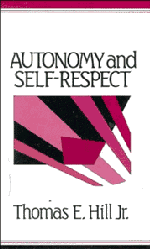Book contents
- Frontmatter
- Contents
- Sources and acknowledgments
- Introduction
- 1 Servility and self-respect
- 2 Self-respect reconsidered
- 3 Autonomy and benevolent lies
- 4 The importance of autonomy
- 5 Symbolic protest and calculated silence
- 6 Moral purity and the lesser evil
- 7 Self-regarding suicide: a modified Kantian view
- 8 Ideals of human excellence and preserving natural environments
- 9 Weakness of will and character
- 10 Promises to oneself
- 11 Social snobbery and human dignity
- 12 Pains and projects: justifying to oneself
- 13 The message of affirmative action
- Index
6 - Moral purity and the lesser evil
Published online by Cambridge University Press: 05 June 2012
- Frontmatter
- Contents
- Sources and acknowledgments
- Introduction
- 1 Servility and self-respect
- 2 Self-respect reconsidered
- 3 Autonomy and benevolent lies
- 4 The importance of autonomy
- 5 Symbolic protest and calculated silence
- 6 Moral purity and the lesser evil
- 7 Self-regarding suicide: a modified Kantian view
- 8 Ideals of human excellence and preserving natural environments
- 9 Weakness of will and character
- 10 Promises to oneself
- 11 Social snobbery and human dignity
- 12 Pains and projects: justifying to oneself
- 13 The message of affirmative action
- Index
Summary
In a morally perfect world we would not face many of the hard choices which confront us in the real world. If everyone were fully conscientious, moral dilemmas might still be posed by natural circumstances; but many of our most difficult and tragic choices would not arise. In particular, we would never need to decide whether we should ourselves do a lesser evil in order to prevent someone else from doing a greater one. Unfortunately we do not live in such a perfect world. Through greed, malice, jealousy, false pride, or whatever, people are prepared to commit the most heinous crimes against innocent victims; and sometimes, it seems, they can be prevented only by means which no one would consider in the morally perfect world. One must choose among evils; doing a lesser evil oneself or allowing others to do an even greater evil.
Harry Truman apparently saw his decision to drop atomic bombs on Hiroshima and Nagasaki in this way. To do so was clearly an evil, a wrong to many innocent people. On the other hand, the Japanese leadership, Truman thought, would otherwise refuse to surrender, causing the deaths of far more people than would be killed by the bombs. The problem, in his view, was set up by the Japanese leaders: they were wrong to bomb Pearl Harbor and would be wrong to continue the war at great cost in 1945.
- Type
- Chapter
- Information
- Autonomy and Self-Respect , pp. 67 - 84Publisher: Cambridge University PressPrint publication year: 1991
- 1
- Cited by

